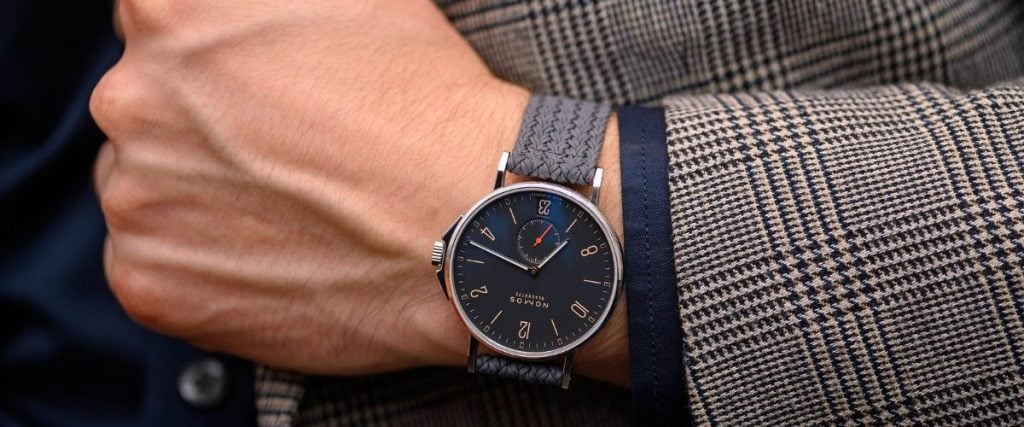
The Psychology of Watch Wearing on the Right Hand

Watches say a lot about us. They speak to our sense of style, our punctuality (or attempts at it), and even our personality quirks. Even the smallest parts of our watches can reveal things about us, whether it’s the color of the dial or even the size of the case. Similarly, did you know that even the wrist you choose to wear your watch can reveal something about you?
Most people automatically go for the left wrist, following a decades-old tradition. But many people are choosing to break from the mold, donning their watches on the right wrist instead.
For some, it’s a matter of comfort or just about practicality. For others, it’s a matter of habit or style. But without us realizing it, there can be some subconscious psychological reasons why we wear our watches on the right hand.
Reasons for Wearing a Watch on the Right Hand
Wearing a watch on the right hand may not be as common, but it’s certainly not unusual. People have all kinds of reasons for making this choice; some practical, some personal, and some just based on habit. Here are some of just a few reasons you might choose to wear a watch on your right wrist:
Tradition
Tradition often plays a big role in why people wear a watch on a particular wrist. Historically, wristwatches were designed with a specific function in mind: to be easily operated without needing to remove them. Most people are right-handed, so the majority of watches are crafted with a small knob on the right side of the watch face called the crown.
This crown allows you to wind the watch and adjust the time, so placing it on the left wrist means you can wind and adjust it using your dominant right hand. Wearing your watch on the left also helps protect the watch from damage since the less dominant hand (the left, for most) is generally less active and thus less likely to bump or scratch the watch.
This left-wrist tradition quickly became the standard in Western culture, with the design of wristwatches reflecting it to this day. However, in some cultures, wearing a watch on the right wrist is more common and even carries its own significance.
In parts of Eastern Europe, South Asia, and the Middle East, for instance, wearing a watch on the right wrist may be linked to cultural norms and values or even religious beliefs. In these regions, people may feel that wearing a watch on the right wrist aligns with certain customs or is seen as a more dignified or respectful choice.
Left-Handed
Being left-handed is one of the most common practical reasons people wear a watch on their right wrist. Since lefties use their left hand for most daily tasks, putting a watch on the right wrist frees up their dominant hand for writing, eating, or using tools.
This means the watch doesn’t interfere with the activities they perform most frequently, where wrist movement and flexibility are essential. Having the watch on their non-dominant wrist also reduces the chance of accidental damage from tasks that involve fine motor skills or pressure, like chopping, writing, or even playing sports.
Wearing the watch on the right wrist also allows left-handed people to adjust or wind the watch more comfortably with their dominant hand.
Many traditional watches are designed with the crown (the knob used to set the time) on the right side, which is ideal for right-handers wearing a watch on their left wrist. When left-handed people wear a right-sided crown watch on their right wrist, they can easily access and operate it with their left hand, which might be much trickier if they wore the watch on the left.
Personal Style
Sometimes, wearing a watch on the right wrist is simply a matter of personal style. Watches are often worn as part of an outfit as a fashion accessory, and rightly so. These timekeeping marvels are made to look good, after all.
So, some people choose to wear their watch on a particular wrist simply because they like how it looks. For some people, a watch on the right wrist feels a bit more unconventional and can help them stand out from the crowd.
It’s like a subtle statement to show they like to be different. Others might choose the right wrist because it fits better with other accessories. For example, they might wear other pieces of jewelry on the left wrist, like bracelets or bangles.
Physiological Issues
Comfort and health considerations play a significant role in how people choose which wrist to wear a watch on, especially for those managing certain physiological conditions or temporary injuries.
For example, for people with carpal tunnel syndrome or tendonitis, the choice of wrist can greatly impact comfort. Carpal tunnel syndrome occurs when the median nerve is compressed as it travels through the wrist, often causing tingling, pain, or numbness.
Wearing a watch on an affected wrist may worsen these symptoms by adding extra pressure to an already sensitive area.
In addition to chronic conditions, injuries like sprains, fractures, or even just soreness from repetitive strain can influence the choice of wrist. For instance, someone with a cast or a bandage on one wrist may naturally shift their watch to the other side.
Some people may also experience swelling due to circulation issues or arthritis, which can cause fluctuations in wrist size and sensitivity. For these individuals, wearing a watch loosely on the less sensitive wrist or switching wrists based on daily comfort can prevent additional pain and allow them to keep wearing their timepieces.
Which Hand Should a Man Wear a Watch on?
Traditionally, men are most commonly seen wearing their watch on the left hand. This trend dates back to the early days of wristwatches when pocket watches were converted into wristwatches and worn on the left hand, making it easier for right-handed men to wind them with their dominant hand. Over time, this became a social norm, and it’s still the standard for many men today.
However, there’s no hard and fast rule that says men must wear their watch on the left wrist. If wearing it on the right hand feels more natural, looks better with other accessories, or simply suits your style, there’s no reason you can’t switch it up. In the end, the wrist you choose says a lot about your personality and your willingness to follow or break tradition.
Which Hand Should a Woman Wear a Watch on?
Interestingly, the social expectations for women’s watch-wearing have been different from those for men. Traditionally, women were more likely to wear their watch on their right hand, though there isn’t a clear reason why this trend emerged. Some say it’s to differentiate from men’s style, while others suggest it simply became a custom over time.
Just like with men, though, this tradition is far from a rule. Women today should choose whichever wrist feels right for them. Some women might stick with the right wrist out of habit or preference, while others may find the left hand more comfortable or practical.
As a female myself, I’m happy to admit my right wrist has always felt the most comfortable for my watches. It was a subconscious decision I made early on, and now I only ever put them on this wrist out of habit. But who knows, maybe I’ll mix it up more often. Ultimately, there’s no right or wrong wrist for a woman to wear her watch on; it should all be personal style and comfort.
Are There Psychological Reasons for Wearing a Watch on the Right or Left Hand?
This is where things get a little interesting and fun. Could the wrist you wear your watch on actually reveal clues about your personality, habits, and even your psychological makeup? Maybe… Psychology often weaves its way into the subtle choices we make, whether it’s our fashion sense or our favorite accessories.
And yes, some people believe that the wrist you choose for your watch, left or right, could hint at certain personality traits or even offer insight into how you navigate life.
For example, since the majority of people (aka right-handers) tend to make the left wrist their default choice, these people are often associated with a sense of tradition and practicality. It’s a convenient choice, as we’ve already explained, since the left hand is less dominant, so the watch is less likely to get in the way of daily tasks.
For that reason, those who stick with this classic placement might be seen as organized and maybe even planners at heart, often valuing order and routine.
You could also argue left wrist watch-wearers are less risk averse, choosing the “typical” wrist because they know it’s tried-and-true and keeps their watch more protected. Alternatively, it may just mean they are detail-oriented, as the traditional placement suggests they value efficiency and don’t feel the need to complicate things, especially when it comes to practical manners.
Explore the
Biggest Pre-Owned Collection of Luxury Watches
Wearing a watch on the right wrist, while less common, is still an option for many and can equally suggest a few things about that person. It could be that the person is simply left-handed, and wearing their timepiece on the right wrist just makes sense. Or it could be that they want to defy the norm and embrace a choice that’s different and unexpected.
This alone reflects their confident personality and proves they value self-expression. It also hints at a bravery to go against the grain. Similarly, those who wear their watch on the right wrist might enjoy approaching things from new angles, bringing a fresh, unconventional mindset to everyday choices.
Interestingly, if you’re right-handed but choose to wear your watch on your right wrist, this could hint at an intentional embrace of self-expression. Maybe it’s a sign that you like to make even small choices of your own.
Similarly, a left-handed person who wears their watch on the left might value comfort but isn’t afraid to endure a bit of awkwardness for the sake of blending in or sticking to what feels “right.”
In the end, whether these assumptions hold true depends entirely on the individual. But there’s something fun about the idea that even a small, everyday choice like which wrist to wear a watch on might reveal a glimpse into someone’s inner workings.
So, if you’re rocking your watch on the “unexpected” wrist, maybe you’re subtly showing the world you’re not one to follow the crowd—or maybe you’re just all about making things work for you in your own way!
Conclusion
At the end of the day, it really doesn’t matter which wrist you choose to wear your watch on. You should decide based on your own wants and needs. If you like to be influenced by tradition or you enjoy the practicality and comfort of wearing it on your left wrist, then do just that. Or, if you see yourself as more of a fashion-forward thinker who wants to stand out, choose your right.
The beauty of watches is that it’s all about you and your personal style. They’re designed to be a reflection of our habits, preferences, and personalities, so wear your watch on the wrist that feels right for you. There are no rules when it comes to watchmaking, let alone watch-wearing, so enjoy the freedom of it and wear your timepiece without any rules.
About Exquisite Timepieces
Established in 1998, Exquisite Timepieces is your one-stop shop for all things luxury watches! We are an authorized dealer for 60+ luxury watch brands including Omega, Hublot, Seiko, & Longines! We are proud to showcase one of the world’s largest pre-owned watch collections, including renowned brands like Rolex and Patek Philippe. Check out our brand new watch arrivals here and popular pre-owned listings here.




















